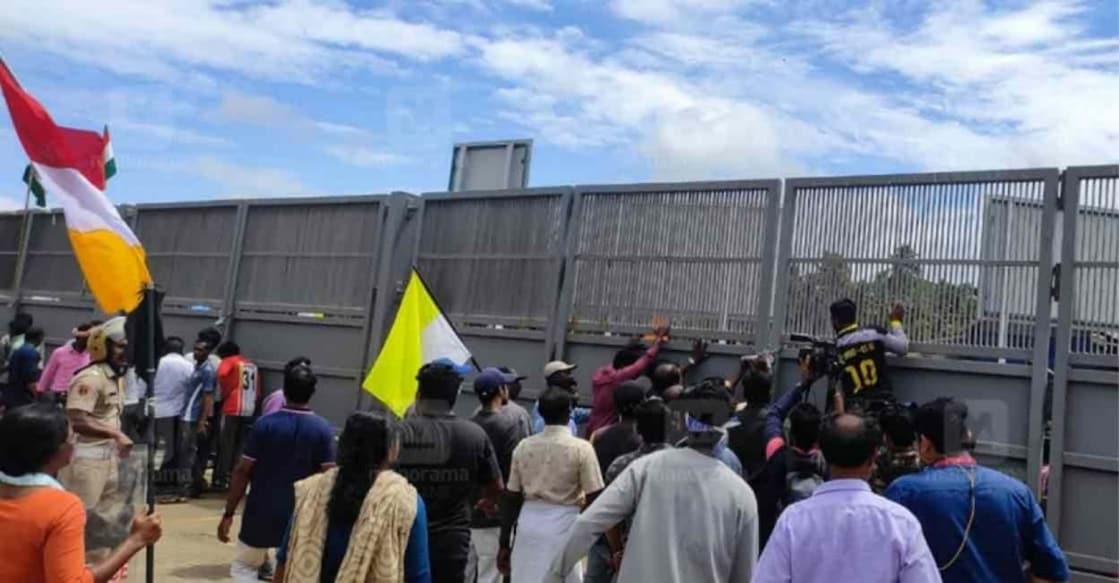Tharoor Line | Govt must help Vizhinjam project-affected people

Mail This Article
The ongoing protests by the Latin church and the fishing community in Vizhinjam point to the challenge of reconciling the tensions between development and the democratic rights of citizens.
The anguish of the coastal people is genuine, and easy to understand. Year after year they have seen their homes and habitations on the seashore being washed away by the relentless onslaught of coastal erosion, their beaches swamped by sea inundations, their buildings toppling into the waves. Things have got worse in recent years. Many fear they are literally going to be pushed out of their own community’s traditional coastal areas, and made to seek refuge in unsuitable places far from the sea, where they make their living. Their anxiety is existential.
They have now started an agitation to fight for their rights. There is no doubt that coastal erosion is real and has not been tackled by the authorities. For a decade now I have raised the issue in Parliament and directly with central ministers, demanding funds for seawalls and groynes to mitigate the force of sea inundations. But the Central government says it is the State government’s responsibility, and the state government says it has no funds. Neighbouring Tamil Nadu has spent Rs 118 crore on constructing such defences on the adjoining coast and so saved their own coastline; Kerala has spent next to nothing in the last several years. The result is that the sea has taken a severe toll on our state.
The fisherfolk have already been battered by the depletion of fish in the nearby seas, frequent “no-fishing” days because of weather disruptions, competition from foreign trawlers beyond India’s territorial waters, the removal of central subsidies on the kerosene that powers their boats, and the inadequate rehabilitation compensation offered by the state government to the displaced. Many people who have lost their homes have literally been “warehoused” in unventilated godowns in sub-human conditions for months. In addition, they, and their spiritual leaders in the Latin Catholic Church, blame some of their recent problems on the construction of the Vizhinjam port, which they claim has changed tidal patterns and worsened the damage to the coastline. They have now launched an agitation that has blocked access to the port site, demanding that the work be stopped.
The state government says they are willing to improve the rehabilitation and compensation offered and identify land nearer the coast to house fisherfolk who have lost their homes to the sea, but that the port construction cannot be stopped. In fact the government has levied fines on the Adani company for not progressing fast enough on the construction; to ask them to even pause now would undermine the very logic of the port project, which had been a dream of Kerala ever since it was first mooted three decades ago.
There is also a great deal at stake for Kerala, and India, in the development of Vizhinjam.

Ships carry 90% of the world’s goods across the seas. Mainline container vessels or “mother ships” carry goods to major, deep-water ports, from where they are transferred to smaller “feeder vessels” that take them to smaller, shallower ports, in a process known as trans-shipment. Currently, the vast majority of India’s container traffic is either being trans-shipped at ports outside the country, mainly at Colombo (Sri Lanka), Singapore, Port Klang and Tanjung Pelapas (Malaysia), Salalah (Oman), and Jebel Ali (Dubai), or delivered by smaller, less efficient ships directly to relatively shallow Indian ports. This is because India currently has no major all-weather, deep-water port near the international sea routes to handle large mainline container vessels. Most ships break their bulk at Colombo, Singapore or Dubai, with the majority of the cargo meant for India or the rest of South Asia.
As a result Colombo trans-ships more Indian goods than all of India's own ports. There are serious geopolitical implications to being dependent on Colombo for trans-shipment, since its latest and biggest terminal is now operated by a Chinese firm. India prohibits Chinese firms from investing in or building its ports, but in effect condones the trans-shipment of the lion's share of our cargo via a Chinese-operated port where Chinese Navy submarines regularly call.
Vizhinjam is meant to be the answer. It is uniquely located close to the shipping routes between Asia and Europe. The key Suez-Malacca shipping lane runs very close to Vizhinjam, some 10 nautical miles away, much closer than to any other Indian port. Vizhinjam has a natural un-dredged draft of up to 24 meters, perfect for the biggest mother vessels. Ships of up to 20,000 TEU or more can easily berth there from day one. Its strategic location on the tip of the peninsula provides not just proximity to the international shipping lanes but also equidistance from both West and East Coast Indian ports. Since Vizhinjam would be built from scratch, it has the ability to deploy “best in class” equipment without being burdened by legacy facilities.
Vizhinjam is therefore potentially a vital strategic asset for India, and a source of major revenue for Kerala for decades to come. Stopping its development would be detrimental to the state’s interests. But ignoring the needs of the people in the name of development makes no sense either. The Latin Catholic Archdiocese of Trivandrum has a great record -- exemplified in their surrender of even their church for the establishment of VSSC in Thumba -- of exemplary devotion to the cause of facilitating India’s progress while safeguarding the rights of the downtrodden. When they are unhappy, they deserve a hearing.

The state government must take steps to improve the rehabilitation of the affected fisherfolk; find the funds to construct sea walls and groynes; and alleviate the burden of high kerosene prices. If this requires Central government assistance, I am willing, as the local MP, to support a request for a special relief package for the state and to lobby for it in Delhi. Development will bring money to the state; but to facilitate it, the state must spend money to help the affected people.
Protect sea borders, too
Tailpiece: I wrote to the Prime Minister to point out that if China had taken even a few square meters of Indian territory, there would be an uproar in Parliament, the government would be shaken and the nation would be up in arms. But the sea has taken 64 square kilometres of Indian territory in my constituency and no one is bothered to find the resources to prevent it. This also the sacred soil of our motherland that is being lost to the nation. Surely we can spend a tiny fraction of the cost of protecting our land borders on protecting our sea borders -- our coastline -- too?


